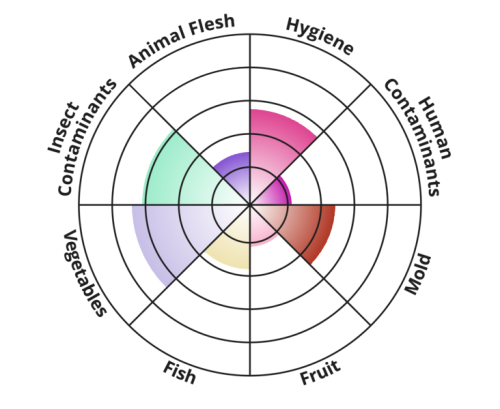This Eye-Opening ‘Food Disgust Test’ Reveals Your Biggest Food Icks in Under 5 Minutes (and It’s Backed by Science)
Take this five-minute Food Disgust Sensitivity Test to reveal your biggest food icks and your perception of certain food contaminants.

Understanding our palates and flavor preferences can be tricky. (Understatement of the year.)
There’s no denying the fact that flavor and textural preferences are a very personal thing—two people can have radically opposing opinions about the same food. (Case in point? Pickles: You either love them or hate ’em.) What you like to eat and the flavors you enjoy change significantly over time, too, partially because our tastebuds age just like the rest of our bodies.
One science-backed way to better grasp your sense of taste is to turn the question on its head and work to discern what foods, aromas, textures, and the like give you the “ick.” But don’t just take it from us: Try taking this Food Disgust Sensitivity Test to help shed some light on your yucks and yums. Fair warning that the results just may make…total sense.
What does a ‘Food Disgust Sensitivity Test’ measure?
Based on the work of Christina Hartmann, PhD, a consumer behavior researcher, and Michael Siegrist, PhD, a risk perception researcher, at the Technical University of Zurich, this Food Disgust Sensitivity Test measures elevated responses to possible contaminants in foods.
For a bit of background information, Dr. Hartmann has dedicated her research to nutrition psychology with a focus on the perception and acceptance of new food sources, factors influencing food preferences development, and food choices. Meanwhile, Dr. Siegrist’s work is on risk perception, risk communication, acceptance of new technologies, and decision-making under uncertainty, with a special interest in food and consumer behavior.
Through their research, the duo uncovered that disgust concerning food could be broken into eight distinct scales, which they coined the Food Disgust Scale (FDS). This includes: hygiene, human contaminants, mold, fruit, fish, vegetables, insect contaminants, and animal flesh. Using this information, they’ve developed a 32-question test with a sliding scale response format. To unveil food disgust sensitivity, participants must rate questions like, “I feel disgusted when I chew on irregular bits of animal meat,” ranging from disagree to agree, broken down into five tiers.

What the 8 food disgust triggers reveal about your food preferences
Animal Flesh
Depending on the responses to the questions, a final diagram will reveal your perception of disgust in the different categories. For example, according to the test, an “Animal Flesh” sensitivity denotes the tendency to experience disgust at raw meat or the less commonly eaten parts of animals (like organs, jaws, tongue, and so on).
“This disgust may also extend to other impressions related to animal flesh, such as the odors of frying or cooking meat or seeing the parts of animals that remind a person that they resemble us—such as faces, feet, eyes, etc,” says Dr. Hartmann and Dr. Siegrist. What’s more, the researchers claim that of all the food disgust triggers, ‘Animal Flesh’ is thought to have “the most cultural basis, and many vegans and vegetarians report increased disgust on this parameter after adopting these diets.”
Hygiene
Next up is the “Hygiene” sensitivity, which is linked to feeling disgusted when unsanitary conditions are present regarding one’s food intake. This means folks might lose their appetite when they notice stains on utensils or dirty dishes. According to the findings, high disgust related to non-ideal hygiene may reduce the risk of infection, but some research also suggests that it may increase one’s risk of autoimmune disease.
Human Contamination
“Human Contamination” is the tendency to experience disgust for contaminants such as already-used cutlery or the idea of sharing food with others. Research indicates that avoiding human contamination might help reduce the risk of consuming toxins or bacteria via food.
Mold
This category refers to moldy foods or food that has had mold removed from it. The study reveals that those that experience an aversion to mold might experience nausea and disgust at merely the thought of eating something with mold.
Decaying Fruit
“Decaying Fruit” is the tendency to avoid overripe or fruits that have changed color or texture. For example, avoiding fruits with black or brown spots or unusually soft to the touch. “This kind of disgust is thought to have originated from the human instinct to avoid rancid or decomposing foodstuffs,” the researchers say.
Fish
Others may experience an aversion to the smell and texture of fish. The researchers say this type of disgust may have evolved due to food preservation issues and the challenges of keeping fish meat fresh in prehistoric times.
Decaying Vegetables
Similar to decaying fruit, folks may experience an aversion to decaying vegetables, which the researchers reveal may be a result of a human instinct to avoid eating spoiled foods.
Insect Contaminants
Lastly, folks might feel disgusted when worms, bugs, and/or insects are present in or near foods. “This type of disgust is thought to have developed as a disease avoidance measure that may reduce the risk of infection,” Dr. Hartmann and Dr. Siegrist say.
TL;DR?
Although these factors may shed light on some food aversions, it’s important to note that all the factors determining why people differ on the various triggers for food disgust are not completely understood. However, the researchers hope to share this tool to help map out individual preferences a bit further.
So, where do you stand? Find out by taking the quiz for yourself.
Sign Up for Our Daily Newsletter
Get all the latest in wellness, trends, food, fitness, beauty, and more delivered right to your inbox.
Got it, you've been added to our email list.










